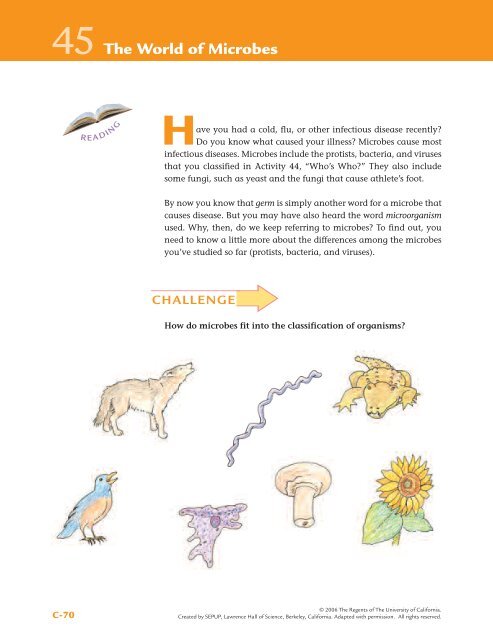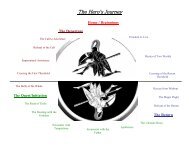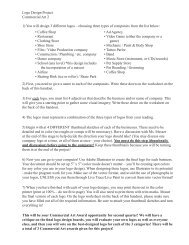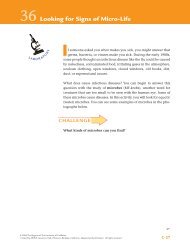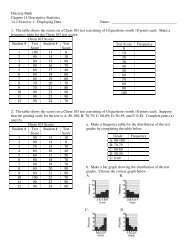Create successful ePaper yourself
Turn your PDF publications into a flip-book with our unique Google optimized e-Paper software.
45 <strong>The</strong> <strong>World</strong> <strong>of</strong> <strong>Microbes</strong>R EA D I N GHave you had a cold, flu, or other infectious disease recently?Do you know what caused your illness? <strong>Microbes</strong> cause mostinfectious diseases. <strong>Microbes</strong> include the protists, bacteria, and virusesthat you classified in Activity 44, “Who’s Who?” <strong>The</strong>y also includesome fungi, such as yeast and the fungi that cause athlete’s foot.By now you know that germ is simply another word for a microbe thatcauses disease. But you may have also heard the word microorganismused. Why, then, do we keep referring to microbes? To find out, youneed to know a little more about the differences among the microbesyou’ve studied so far (protists, bacteria, and viruses).CHALLENGEHow do microbes fit into the classification <strong>of</strong> organisms?C-70© 2006 <strong>The</strong> Regents <strong>of</strong> <strong>The</strong> University <strong>of</strong> California.Created by SEPUP, Lawrence Hall <strong>of</strong> Science, Berkeley, California. Adapted with permission. All rights reserved.
<strong>The</strong> <strong>World</strong> <strong>of</strong> <strong>Microbes</strong> • Activity 45READINGClassifying OrganismsUntil recently, scientists classified organisms into five groups, calledKingdoms, as shown in Figure 1. New evidence has led to several alternativesto the five-kingdom system. Classification is a way to makesense <strong>of</strong> a lot <strong>of</strong> information. As the information changes, new classificationsystems evolve. For example, scientists have learned that bacteriacan be divided into two very different groups, called Bacteria andArchaea. Still, it is useful for you to think about five different groups <strong>of</strong>organisms: animals, plants, fungi, protists, and bacteria.Figure 1: <strong>The</strong> Five-Kingdom Classification SchemeAnimals Plants Fungi Protists BacteriaYou are most familiar with animals and plants. <strong>The</strong>y make up twokingdoms. A third kingdom is made up <strong>of</strong> fungi. <strong>The</strong> fungi includeyeasts (like the one you used in Activity 39, “Cells Alive!”), molds, andmushrooms. Protists and bacteria, like the ones you observed in Activity43, “<strong>Microbes</strong> Under View,” belong to two more groups <strong>of</strong> organisms.Notice that viruses are not included in the figure because theyare not considered to be living organisms.STOPPING TO THINK 1Think about all <strong>of</strong> the slides you have observed. Have youobserved cells <strong>of</strong> organisms from every kingdom? List all the cellsyou have observed from organisms in each kingdom.➢© 2006 <strong>The</strong> Regents <strong>of</strong> <strong>The</strong> University <strong>of</strong> California.Created by SEPUP, Lawrence Hall <strong>of</strong> Science, Berkeley, California. Adapted with permission. All rights reserved.C-71
Activity 45 • <strong>The</strong> <strong>World</strong> <strong>of</strong> <strong>Microbes</strong>ProtistsProtists are single-celled microbes that have a nucleus. While someprotists cause illness, many others are harmless. <strong>The</strong> Trypanosoma thatyou observed in Activity 43 is closely related to another type <strong>of</strong> Trypanosomathat causes sleeping sickness in people. Species <strong>of</strong> Parameciumare <strong>of</strong>ten harmless, living in fresh and salt water, where they feedon bacteria, algae, and other protists. Many types <strong>of</strong> Amoeba areharmless, while others cause illnesses <strong>of</strong> the digestive system.BacteriaBacteria are single-celled microbes that do not have a nucleus. Bacteriaare also the most common microbes and can be found everywhere—insnow, deserts, lakes, the ocean, and the human body. Asyou may recall, bacteria are extremely tiny; a thousand bacteriacould fit in a cluster on the dot <strong>of</strong> an “i.” <strong>The</strong>re are more bacterial cellsin your digestive system and on your skin than the number <strong>of</strong> cellsthat make up your entire body!While some bacteria, such as Mycobacterium tuberculosis, cause diseases,other species <strong>of</strong> bacteria are helpful. In fact, without bacteria,nothing would ever decompose; the world would be full <strong>of</strong> deadorganisms, from the tiniest microbes to large plants and animals! Bacteriaalso are important in the preparation <strong>of</strong> foods and beverages.You may have noticed a statement on some yogurt containers: “containslive and active yogurt cultures.” That’s because yogurt is producedby the fermentation <strong>of</strong> milk by bacteria! Figure 2 shows theshapes and some information about different kinds <strong>of</strong> bacteria.STOPPING TO THINK 2Would you describe bacteria as being helpful or harmful to people?Explain.C-72© 2006 <strong>The</strong> Regents <strong>of</strong> <strong>The</strong> University <strong>of</strong> California.Created by SEPUP, Lawrence Hall <strong>of</strong> Science, Berkeley, California. Adapted with permission. All rights reserved.
<strong>The</strong> <strong>World</strong> <strong>of</strong> <strong>Microbes</strong> • Activity 45Figure 2: Some Common Types <strong>of</strong> BacteriaShape Examples Ecological RolesDiplococci(pairs <strong>of</strong> cocci)cause pneumoniasphere Staphylococci are normally present on human skin;(clusters <strong>of</strong> cocci)some cause boils and infectionsStreptococci(chains <strong>of</strong> cocci)are used to make yogurt and cheese; causestrep throatrodBacilli (rods)Mycobacteria(chains <strong>of</strong> bacilli)decompose hay; are used to make cheese,yogurt, pickles, and sauerkraut; arenormally present in the human digestivetract; cause diarrhea; cause anthrax incattle and sheepcause tuberculosis; are found normally insoil and water.curved rod Vibrio cause cholera; help break down sewageshort spirals Spirilla are decomposers in both fresh andsalt waterlong spirals Spirochete cause syphilis; are decomposersbranched chain Actinomyces produce several antibiotics; were onceclassified as fungiCocci are spherical bacteria; the singular <strong>of</strong> cocci is coccus.➢© 2006 <strong>The</strong> Regents <strong>of</strong> <strong>The</strong> University <strong>of</strong> California.Created by SEPUP, Lawrence Hall <strong>of</strong> Science, Berkeley, California. Adapted with permission. All rights reserved.C-73
Activity 45 • <strong>The</strong> <strong>World</strong> <strong>of</strong> <strong>Microbes</strong>Viruses: A Group ApartViruses are not living organisms. Unlike protists, bacteria, and allother living organisms, viruses are not made up <strong>of</strong> cells. <strong>The</strong>y areunable to grow or reproduce independently or carry out the functions,such as respiration, that living organisms do. Instead, viruses rely onthe cells <strong>of</strong> living organisms for their reproduction. It is for this reasonthat we say infectious diseases are caused by microbes, and notmicroorganisms.virusbacteriumprotistFigure 3: Comparing Average Sizes <strong>of</strong> <strong>Microbes</strong><strong>The</strong>se are relative, not actual, sizes <strong>of</strong> microbes. An average bacterium is actually muchsmaller than the virus shown here.STOPPING TO THINK 3a. Why are viruses not considered to be microorganisms?b. Look at Figure 3, “Relative Sizes <strong>of</strong> <strong>Microbes</strong>.” How do the sizes<strong>of</strong> protists, bacteria, and viruses compare?c. Which do you think cannot be seen with a classroom microscope?How do we know viruses exist? <strong>The</strong> existence <strong>of</strong> viruses was first suggestedin 1898, nearly 45 years before they were first seen. In 1895,Dutch scientist Martinus Beijerinck (BY-er-ink) began experimentingwith the tobacco plant. He was studying a plant disease that hebelieved to be infectious. By this time, scientists were familiar withprotists and bacteria, so Beijerinck began searching for a bacteriumthat might be causing this disease. But he could not find one. Yet hisexperiments demonstrated that the disease could be passed fromplant to plant, so he concluded that the disease was caused by amicrobe. Since it wasn’t a protist or a bacterium, he called it a virus,which means “poison” in Latin.C-74© 2006 <strong>The</strong> Regents <strong>of</strong> <strong>The</strong> University <strong>of</strong> California.Created by SEPUP, Lawrence Hall <strong>of</strong> Science, Berkeley, California. Adapted with permission. All rights reserved.
<strong>The</strong> <strong>World</strong> <strong>of</strong> <strong>Microbes</strong> • Activity 45Viruses are so small that you need an electron microscope to see one.<strong>The</strong> electron microscope was not invented until the 1930s. As a result,viruses were first seen in 1939. Today, we know that viruses causemany diseases, including the flu, colds, chickenpox, and AIDS.Figure 4: Classifying Disease-Causing Organisms and VirusesFigure 4 shows the five-kingdom classification plus viruses. Note theexamples <strong>of</strong> diseases caused by members <strong>of</strong> each group. What do youthink the dotted lines mean?For links to more information about microbes, go the SALI page <strong>of</strong> theSEPUP website.ANALYSIS1. You have read how microbes can be both helpful and harmful tohumans. Do you think a microbe can be neither helpful norharmful? Explain.2. You decide to examine some pond water under a microscope. Witha magnification <strong>of</strong> 40 (using the 4x objective), you observe a long,cylindrical organism moving across your field <strong>of</strong> view (see left). Asyou look more closely, you notice what appears to be a round structureinside <strong>of</strong> it. Is this organism most likely a protist, bacterium,or virus? Explain how you arrived at your conclusion.➢© 2006 <strong>The</strong> Regents <strong>of</strong> <strong>The</strong> University <strong>of</strong> California.Created by SEPUP, Lawrence Hall <strong>of</strong> Science, Berkeley, California. Adapted with permission. All rights reserved.C-75
Activity 45 • <strong>The</strong> <strong>World</strong> <strong>of</strong> <strong>Microbes</strong>3. Suppose your school’s microscopes did not have 40x objectives, butonly 10x objectives. Your friend, who is in high school, uses a 40xobjective. Explain what group <strong>of</strong> microbes he or she can study thatyou cannot.4. What are the advantages <strong>of</strong> using the highest power objective ona microscope? What are the advantages <strong>of</strong> using the lowest powerobjective on a microscope? Explain.5. In your science notebook, draw a larger version <strong>of</strong> the Venn diagramshown below. Record unique features <strong>of</strong> each group <strong>of</strong>microbes in the appropriate space. Record common featuresamong groups in the spaces that overlap. Hint: Think about whatyou have learned about cells in the last few activities.ProtistsBacteriaViruses6. Reflection: On a field trip, you visit a laboratory that has an electronmicroscope. <strong>The</strong> microscopist (the person who runs the microscope)<strong>of</strong>fers to set up a microbe for you to view. What microbe, orgroup <strong>of</strong> microbes, would you choose to view? Why?C-76© 2006 <strong>The</strong> Regents <strong>of</strong> <strong>The</strong> University <strong>of</strong> California.Created by SEPUP, Lawrence Hall <strong>of</strong> Science, Berkeley, California. Adapted with permission. All rights reserved.


